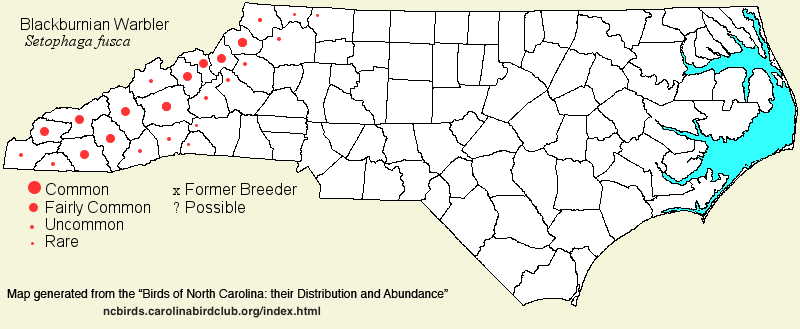 |  |
|
Blackburnian Warbler - Setophaga fusca PARULIDAE Members: | Search Common: Search Scientific: |
|
|
|||||||
| General Comments | The Blackburnian Warbler is one of the most beautiful of our songbirds, as the bright orange breast of the male contrasts with the black and white of the remainder of the plumage. It is one of many warblers whose breeding range is the northern/boreal spruce-fir forests, ranging south through the Appalachians. Though it is a transient over the rest of the state, it migrates mostly west of the Fall Line, even in the fall season. Overall numbers of this and many passerine birds have declined somewhat over the past few decades, perhaps owing mostly to loss of wintering habitat in the tropics. Though its overall breeding range is the "boreal forest zone", it is often found in our mountains in northern hardwood and cove hardwood forests, where males can be quite conspicuous when singing in late Apr and early May, before the leaves emerge. However, it is most numerous in spruce-fir and spruce-hardwood forests, and it also occurs in cooler areas where White Pines and hemlocks are present. Migrants are found mainly in hardwood forests and woodlots. | ||||||
| Breeding Status | Breeder | ||||||
| NC BRC List | Definitive | ||||||
| State Status | |||||||
| U.S. Status | |||||||
| State Rank | S4B | ||||||
| Global Rank | G5 | ||||||
| Coastal Plain | Transient. In spring, very rare over the region, and probably casual in most of the eastern portions, except along the coast, where rare to very rare. In fall, uncommon in the western portions, to rare to uncommon farther eastward; one of the least numerous of the warblers along the coast at that season. Mainly early May to late May, and mid-Sep to mid-Oct. Peak counts: | ||||||
| Piedmont | Transient. In spring, rare across the region, more numerous in the western portion, though still scarce there. In fall, uncommon throughout. Mainly early to late May, and late Aug to mid-Oct. Peak counts: | ||||||
| Mountains | Summer resident, with migratory movements. In summer, fairly common over the region as a whole, but scarce in the northernmost counties and also in the southwestern corner; most numerous in some of the southern counties close to the Blue Ridge Parkway. Mainly above 3,000 feet, but does nest in cool ravines at lower elevations. Fairly common transient, at times common in fall. Mainly late Apr to mid-Oct. One photographed at the Asheville School (Buncombe) on 24 Nov 2019 was exceedingly late. Peak counts: | ||||||
| Finding Tips |
You should be able to find the species in the spruce-hardwood zone (4,500 to 5,500 feet) along the Blue Ridge Parkway, as well as in Mount Mitchell SP and many other sites -- in May and June. *** | ||||||
| Attribution | LeGrand[2023-04-07], LeGrand[2020-02-08], LeGrand[2012-10-02] | ||||||
| NC Map Map depicts all counties with a report (transient or resident) for the species. | Click on county for list of all known species. |
| NC Breeding Season Map Map depicts assumed breeding season abundance for the species. |  |